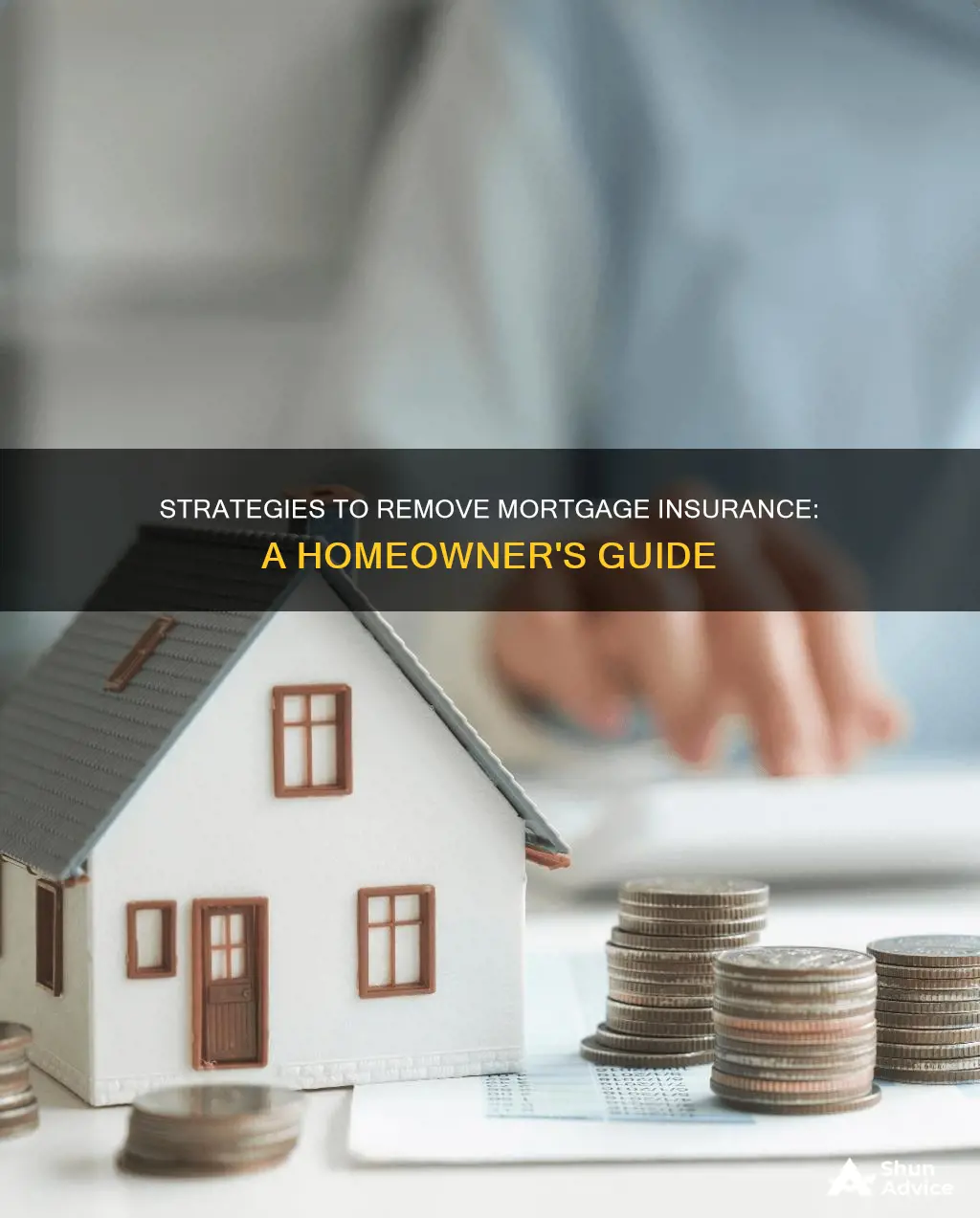
Private mortgage insurance (PMI) is a surcharge that increases your monthly mortgage payment. It is required if you put down less than 20% of the home's cost when taking out a conventional loan. The good news is that PMI doesn't last forever, and there are several ways to get rid of it. In this article, we will explore the different methods to remove or cancel PMI from your mortgage, including automatic cancellation, refinancing, and requesting early removal. We will also discuss the factors that influence PMI cancellation and provide tips on reducing your monthly costs by eliminating this expense.
| Characteristics | Values |
|---|---|
| PMI removal | Once the mortgage balance reaches 78-80% of the home's original value or halfway through the loan term, whichever comes first |
| PMI removal request | Can be made once the mortgage balance reaches 80% of the home's original value |
| PMI removal request | Can be made once 20% equity is reached |
| PMI removal request | Can be made after 2 years of the first payment with no missed payments longer than 60 days |
| PMI removal request | Can be made by refinancing into a new conventional loan with at least 20% home equity |
| PMI removal request | Can be made by refinancing into a piggyback loan with less than 20% home equity |
| PMI removal request | Can be made by refinancing with a first and second mortgage to cover 80% of the home's value and the remaining balance of equity respectively |
| PMI removal request | Can be made by providing evidence of an increase in the home's value |
| PMI removal request | Can be made by writing a letter to the lender |
What You'll Learn

Understanding PMI and MIP
When it comes to mortgages, there are two main types of insurance that you may encounter: Private Mortgage Insurance (PMI) and Mortgage Insurance Premium (MIP). The type of insurance you'll need will depend on the type of loan you take out.
PMI
PMI is a type of insurance that is typically required for conventional loans. A conventional loan is one that is not backed by a government program and meets the requirements to be sold to Fannie Mae or Freddie Mac. If you are taking out a conventional loan and make a down payment of less than 20%, you will usually be required to pay for PMI. This insurance protects the lender in case you default on your loan. It's important to note that PMI can be removed once you have paid down your mortgage to a specified point, which is typically when your mortgage reaches 78-80% of the original value of your home.
MIP
MIP, on the other hand, is associated with FHA loans, which are loans backed by the Federal Housing Administration. All FHA loan borrowers must pay MIP, regardless of their down payment amount or equity. Like PMI, MIP protects the lender in case of default. There are two types of MIP: Upfront MIP (UFMIP), which is a one-time payment usually made at closing that is typically 1.75% of the total loan amount, and Annual MIP, which is based on the total loan amount, loan term, and the amount of the down payment.
Choosing between PMI and MIP
When choosing between PMI and MIP, it's important to compare the costs and benefits of conventional loans and FHA loans. Conventional loans may be preferable for those who can make a higher down payment, while FHA loans may be more affordable for those who cannot. Additionally, borrowers with excellent credit may be able to access lower interest rates with conventional loans compared to FHA loans. Ultimately, the decision between PMI and MIP should be made based on a comprehensive understanding of the associated costs and benefits of each loan type.
The Texas Mortgage Conundrum: How Do They Afford It?
You may want to see also

PMI on single-unit and vacation homes
Private mortgage insurance (PMI) is an added expense for borrowers who take out a conventional loan with a down payment of less than 20%. PMI provides a payment for part of the outstanding loan amount if a borrower defaults on their loan. While PMI is not required when the down payment is 20% or more, lenders may offer lender-paid mortgage insurance (LPMI) in the form of a higher interest rate on the loan.
PMI is also required for second homes or vacation homes with a down payment of less than 20%. Second home mortgages are loans used to finance the purchase of a secondary residence, such as a vacation home, that the borrower intends to occupy for part of the year. The most important requirement for a second home mortgage is a down payment of at least 10%.
There are several ways to get rid of PMI on a single-unit or vacation home. One way is to reach 20% equity in your home, at which point you can request to cancel PMI. Another way is to wait for the loan term to reach its halfway point, at which point the mortgage lender is required to automatically cancel PMI. Additionally, PMI can be removed by refinancing, although this may involve closing costs and a higher interest rate.
It is important to note that the requirements for removing PMI on a multi-unit or investment property may differ from those of a single-unit or vacation home. For example, mortgage insurance on a multi-unit property will automatically cancel halfway through the loan term. Therefore, it is essential to understand the specific requirements for your property type before attempting to remove PMI.
Making Money from Mortgage Pools: A Smart Investment Strategy
You may want to see also

Cancelling PMI halfway through the loan
If you have a mortgage with an interest-only period, principal forbearance, or a balloon payment, your PMI will automatically be cancelled halfway through the loan's original term. This also applies to multi-unit properties or rentals purchased from Fannie Mae or Freddie Mac. You can also request that the lender cancel PMI sooner, when your mortgage balance hits 80% of the home's purchase price. To do this, you must make the PMI cancellation request to your lender or servicer in writing, be current on your mortgage payments, and confirm there are no other liens on your home. If you have made additional payments, you can request to cancel PMI ahead of the scheduled date. If you have 20% equity in your home, you may be able to cancel PMI.
If you are looking for a multi-unit property of up to four units or any investment property, the requirements are slightly different. The rules vary depending on who purchased your loan. There are lookup services for Fannie Mae and Freddie Mac. If your investment property or multi-unit home loan is owned by Freddie Mac, there is no automatic cancellation of mortgage insurance.
If you have a conventional loan, you can get into a home with as little as 3% down. However, you will have to pay private mortgage insurance (PMI). PMI provides a payment for part of the outstanding loan amount if a borrower defaults on their loan. While lenders get peace of mind for taking on additional risk, it also benefits those looking to buy or refinance a home because they can get mortgages with down payments.
PMI can raise your mortgage payment, but there are ways to get rid of it ahead of schedule, including refinancing, a reappraisal, or by paying down your mortgage faster. If you put less than 20% down on your home with a conventional mortgage, you are probably familiar with PMI. It is a surcharge that adds to your monthly mortgage payment, but it does not last forever. The Homeowners Protection Act of 1998 (HPA) requires that mortgage lenders or servicers automatically cancel PMI when the mortgage's loan-to-value (LTV) ratio reaches 78% of the home's purchase price, or when the loan term is at its halfway point, whichever comes first.
Subprime Mortgages: A Recipe for Economic Collapse
You may want to see also

Requesting PMI cancellation
If you have made additional payments that reduce the principal balance of your mortgage to 80% of the original value of your home, you can ask to cancel PMI ahead of the scheduled date. The original value of your home is either the contract sales price or the appraised value at the time of purchase, whichever is lower. However, if you have refinanced, the original value is the appraised value at the time of refinancing.
It is important to note that your servicer is legally required to grant your request to cancel PMI as long as you meet the criteria. These criteria include providing evidence, such as an appraisal, that the value of your property has not declined below the original value. If the value of your property has decreased, you may not be able to cancel PMI as planned.
Additionally, if you are close to the 20% equity mark, refinancing to a new loan with a lower balance could help you reach the PMI cancellation window sooner. However, refinancing is not free, and it typically only makes sense if you can lower your interest rate. Nevertheless, it is an option to consider if you are looking to get rid of PMI.
Single Homeowners: Strategies for Affording a Mortgage
You may want to see also

Refinancing to remove PMI
Private mortgage insurance (PMI) is a type of insurance that applies to mortgages where the homeowner holds less than 20% equity. It provides a payment for part of the outstanding loan amount if a borrower defaults on their loan. While PMI is beneficial for lenders, it also benefits those looking to buy or refinance a home as it allows them to get mortgages with lower down payments.
Federal law requires lenders to automatically cancel PMI when the balance of the mortgage drops to 78% of the home's purchase price or when the loan term is halfway through, whichever comes first. However, you can request to have PMI removed early if you have made additional payments that reduce the principal balance of your mortgage to 80% of your home's value. To do this, you will need to provide an appraisal to show that the value of your property has not declined.
If you are unable to get PMI removed by your lender, refinancing may be an option. Refinancing can help you remove PMI if the value of your home has increased enough to reduce your loan-to-value ratio (LTV) to 80% or less. Once you have been pre-approved for a mortgage refinance and have locked in your rate, your lender will order a home appraisal to determine the current value of your home. If your mortgage balance is less than or equal to 80% of your home's appraised value, then your new refinance loan will not include PMI.
It is important to note that refinancing may come with additional costs, such as closing costs and appraisal fees. Therefore, it is recommended to shop around and compare rates from multiple lenders before making a decision. Additionally, if you have an FHA loan, you may need to refinance to remove PMI, as it cannot be waived.
Navy Federal Mortgages: Competitive Rates, What Else?
You may want to see also
Frequently asked questions
PMI stands for Private Mortgage Insurance. It is a surcharge that is added to your monthly mortgage payment if you put less than 20% down on your home with a conventional mortgage.
There are several ways to get rid of PMI. You can wait until your lender or servicer automatically cancels PMI when your mortgage balance reaches 78% of your home's purchase price, or the month after the halfway point of your loan's term. You can also request to have it removed earlier by making additional principal payments or refinancing your mortgage.
Ending PMI reduces your monthly costs as it is an additional charge on top of your regular mortgage payment.







